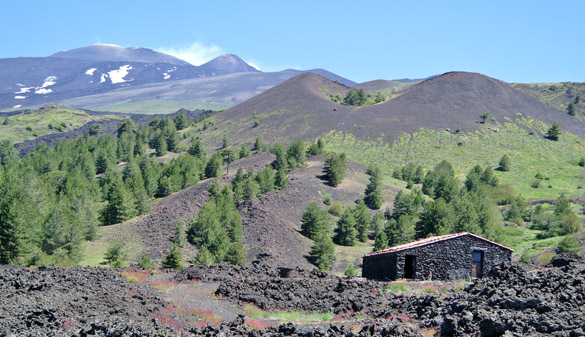 CATANIA, SICILY, ITALY–The International Bryozoology Association conference field trip began with a day on the magnificent compound basaltic stratovolcano that virtually defines the eastern half of Sicily: Mount Etna. We did not get to climb all the way to the top — that would have been a bit of an expedition — but we hiked around its diverse southern flank. The view above is looking toward the summit in the back left, a parasitic cone from an 18th Century eruption in the middleground, and in the bottom right is a trekkers cabin built (of course) almost entirely of vesicular basalt.
CATANIA, SICILY, ITALY–The International Bryozoology Association conference field trip began with a day on the magnificent compound basaltic stratovolcano that virtually defines the eastern half of Sicily: Mount Etna. We did not get to climb all the way to the top — that would have been a bit of an expedition — but we hiked around its diverse southern flank. The view above is looking toward the summit in the back left, a parasitic cone from an 18th Century eruption in the middleground, and in the bottom right is a trekkers cabin built (of course) almost entirely of vesicular basalt.
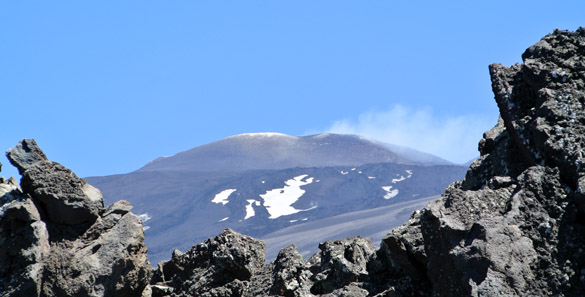 Here is a closer view of the summit. The white smoke on the right is from active fumaroles near the top. Etna is one of the most active volcanoes in the world. Last month, in fact, it was erupting so much that a visit like ours today would not have been allowed. I ticked off a geological bucket list item: standing on an active volcano’s slopes. It is not close to the activity Dr. Pollock and her students have witnessed in Iceland over the years, but exciting for this paleontologist!
Here is a closer view of the summit. The white smoke on the right is from active fumaroles near the top. Etna is one of the most active volcanoes in the world. Last month, in fact, it was erupting so much that a visit like ours today would not have been allowed. I ticked off a geological bucket list item: standing on an active volcano’s slopes. It is not close to the activity Dr. Pollock and her students have witnessed in Iceland over the years, but exciting for this paleontologist!
Sicily lies at the boundary between the African and European tectonic plates, producing an extremely complex geological situation that is still debated. We know, at least, that Mount Etna’s ancestors began erupting underwater about 600,000 years ago, and the axis of eruptive activity has slowly moved to the northwest. We are essentially looking at a series of successive volcanoes intersecting and overlapping previous versions.
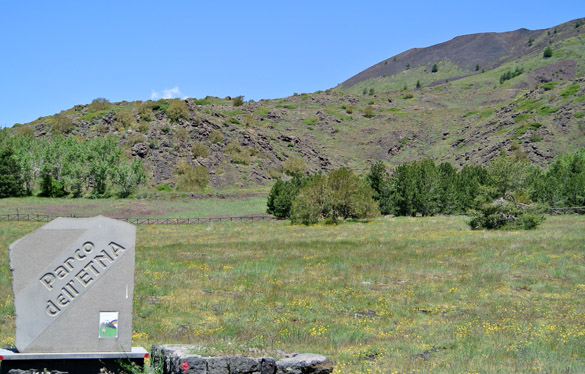 This is the entrance we used into the national Parco dell’etna on the south side of the volcano. Note the perfect weather and the delightful contrast between the jet-black rock and greenery. There was less and less vegetation as we moved upslope.
This is the entrance we used into the national Parco dell’etna on the south side of the volcano. Note the perfect weather and the delightful contrast between the jet-black rock and greenery. There was less and less vegetation as we moved upslope.
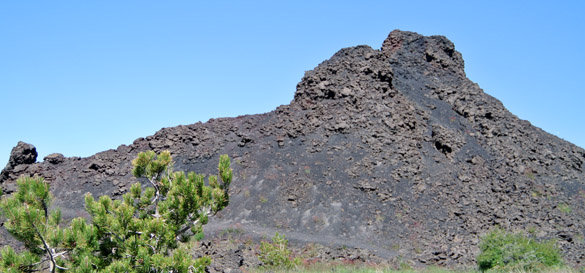 This is the outside of a parasitic cone on the flank of the volcano. Through it emerged a lateral flow of lava.
This is the outside of a parasitic cone on the flank of the volcano. Through it emerged a lateral flow of lava.
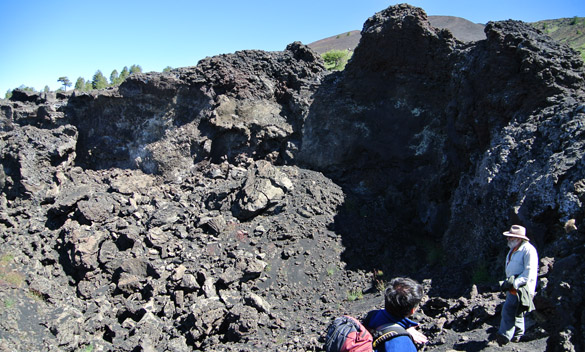 This is the inside of the same cone as above. The rest of it collapsed after the lava completely exited.
This is the inside of the same cone as above. The rest of it collapsed after the lava completely exited.
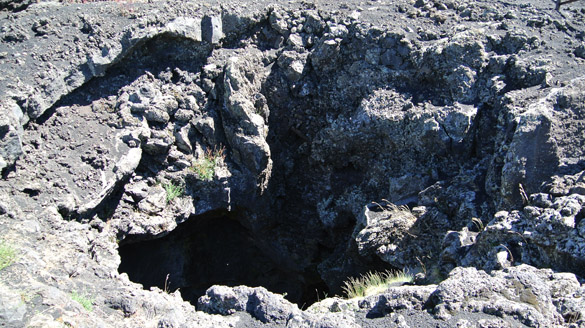 The entrance to a lava tube. The lava flowed through its own hardened crust, leaving behind this rocky tunnel that looks very much like the ancient lava tube we visit on our Mojave Desert field trip. This particular one dates back to the 18th Century. Technically we’re looking through a window to the floor of the lava tube itself.
The entrance to a lava tube. The lava flowed through its own hardened crust, leaving behind this rocky tunnel that looks very much like the ancient lava tube we visit on our Mojave Desert field trip. This particular one dates back to the 18th Century. Technically we’re looking through a window to the floor of the lava tube itself.
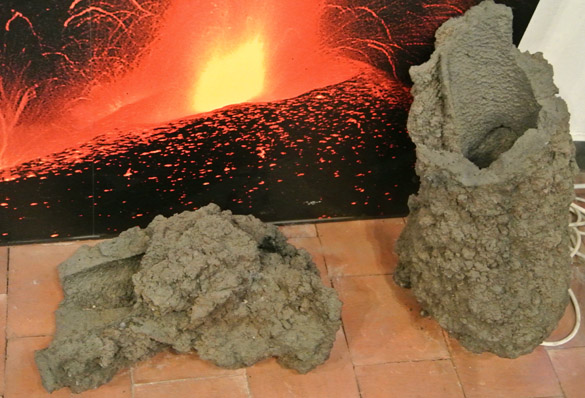 Who says you can’t see fossils on an active volcano? These are basalt external molds of tree trunks formed when a flow of lava engulfed a forest. These are in the Parco dell’etna headquarters.
Who says you can’t see fossils on an active volcano? These are basalt external molds of tree trunks formed when a flow of lava engulfed a forest. These are in the Parco dell’etna headquarters.
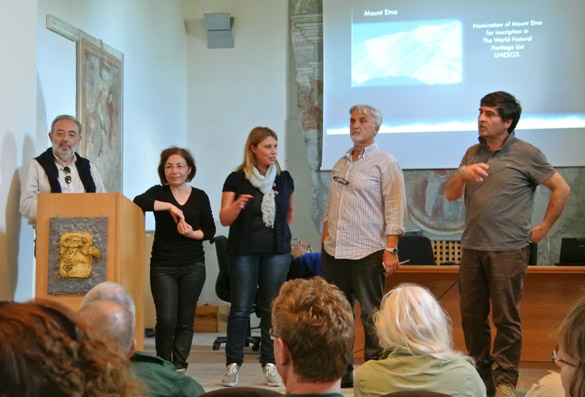 When we visited the Parco dell’etna headquarters, we heard a brief presentation in the chapel of the abandoned monastery they occupy. The president of the park then addressed us. Can you tell which of the five people above is the president? (Hint: She’s wearing a scarf.) They are excited to announce that Mount Etna is now a UNESCO World Heritage site.
When we visited the Parco dell’etna headquarters, we heard a brief presentation in the chapel of the abandoned monastery they occupy. The president of the park then addressed us. Can you tell which of the five people above is the president? (Hint: She’s wearing a scarf.) They are excited to announce that Mount Etna is now a UNESCO World Heritage site.
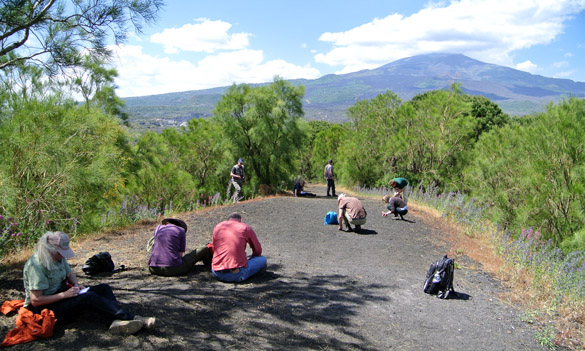 Our last geological activity on Mount Etna for this week was a visit to the top rim of an eroded parasitic cone to find tiny little euhedral crystals of the mineral pyroxene (or, rather, a mineral from the pyroxene group). Here you see paleontologists in a very familiar pose but doing something distinctly unpaleontological.
Our last geological activity on Mount Etna for this week was a visit to the top rim of an eroded parasitic cone to find tiny little euhedral crystals of the mineral pyroxene (or, rather, a mineral from the pyroxene group). Here you see paleontologists in a very familiar pose but doing something distinctly unpaleontological.
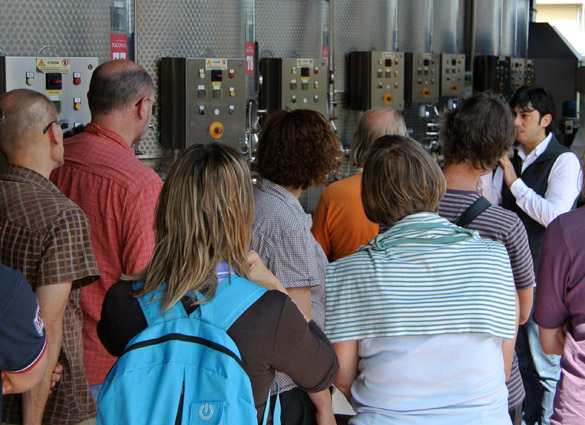 We ended the day at the very modern Nicosia winery where they grow the grapes in the rich volcanic soil on the slopes of Mount Etna. It was very interesting to see the industrial production of various types of wines, but I’m afraid the wine tasting was wasted on me.
We ended the day at the very modern Nicosia winery where they grow the grapes in the rich volcanic soil on the slopes of Mount Etna. It was very interesting to see the industrial production of various types of wines, but I’m afraid the wine tasting was wasted on me.
We will visit Mount Etna once again when the full conference starts next week. I’ll have more images from a different part of the volcano. Tomorrow’s field trip is going to be along the seashore, so there will be some very different images.



A volcano/winery field trip? Why wasn’t I invited? Looks like a blast. Say hello to my former Dickinson colleague, Marcus, if you see him. Enjoy!